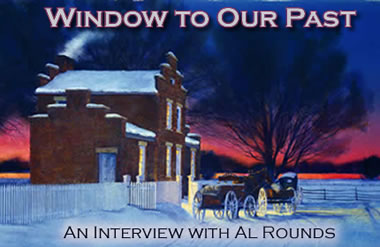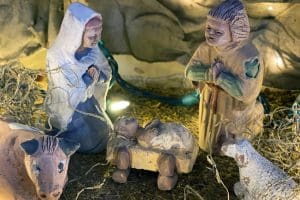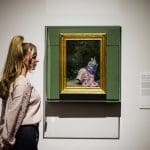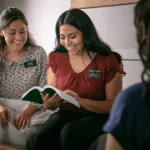![]()

By Steevun Lemon
To search for other art work from Latter-day Saint and other artists, please visit Repartee Gallery.
As one thinks of artists painting historical Church sites, there is one artist preeminent: Al Rounds. Beginning with his first print of Eagle Gate in 1978, Al has painted every major LDS site from Liverpool to Los Angeles. Over the past twenty-five years, Al’s work has transported us to earlier times, including South Temple as Brigham saw it and Joseph’s view of Nauvoo.
I recently had the opportunity to interview Al, and afterward, as I sat in my office and read over the transcript, I found myself laughing out loud and smiling the rest of the day. I hope this interview leaves you laughing as well.
When did you start painting?
My earliest memory was in third grade. It was back-to-school night and I went with my parents. One of the girls in my class pointed at me and said, “There is the artist in our class.” That was the first time I was labeled as an artist. I was constantly in trouble for drawing in church. My parents had a rule that we could not draw until the sacrament was over, but I could never wait that long.
What was the first painting you ever sold?
My mother sold it for me. Knowing my mother, she bought the painting and gave it to her friend and told me the friend bought it. I was in high school and it sold for twenty-five dollars. In high school in the 70’s that was a lot of money.
Who was your greatest inspiration?
My parents. They didn’t know a thing about art, and I don’t remember them taking me to the museums in San Francisco where I grew up, but they were always encouraging me to draw.
Then in high school I had an English teacher, Miss Hildegard Beuquette, who saw my talent and encouraged me not to come to English and instead use the time to paint. I remembering her telling me, “If you do anything with your life except paint, you will be wasting your life.”
I believed her; I believed everything that women said.
Who was your first mentor?
I graduated from Del Valle High School in Walnut Creek, California . It was the summer of 1972 and one of my friends was going to Dixie College in Southern Utah and asked me to come. I told Miss Beuquette about it and she said, “Go.”
I didn’t know where St. George Utah was, but three weeks later I was attending class. I met Jerry Olsen there. He was my first real mentor and a wonderful watercolorist. He gave me the focus I needed to improve my skills. I remember I was playing soccer at the time. Jerry asked me if I had signed up for afternoon painting class. I told him, “No, I play soccer then.”
He replied, “Well, what do you want to do, become a soccer player or an artist?”
When I told him I wanted to be an artist he said, “Then come and paint.”
Jerry got me over the hump and got me serious about painting all of the time. When everyone went to dinner or basketball, I would go paint. That was a hard choice for me because I loved sports.
Did you become a watercolorist because of Jerry Olsen?
No. I hated watercolor. With other media like oils or clay you learn control first and then you let go. But with watercolor you never control it.it controls you. Like this Bountiful Temple painting I have been working on for two weeks. I had to start over because I lost the sky. Watercolor has a mind of its own. Even after all these years it has its own personality.
And you like that?
[Laughing] Yeah, I do. I like that. I can’t even copy my own things. I actually focused on watercolors to survive. When I first started out I had to sell three paintings a day at twenty-five dollars each to pay my bills. I could not do three oil paintings a day, but I could paint three small watercolors and make a living. I would do the oil paintings at night.
At first I hated watercolors but over time I began to see all of the possibilities. If I did it like this, or made it big, or made it more like an oil painting, you get the picture (no pun intended).
When was the last time you painted in oils?
My daughter is an artist so I help her from time to time, but I have not painted in oils on my own for twenty years.
Why did you choose historical church sites?
In 1979, I had a feeling that I needed to go back and follow the migration of the Mormons and specifically the Mormon Trail. We started in Vermont and worked our way back to Utah. I did ten paintings from that trip and it was fun. But I didn’t think of it as historical church sites, it was just painting and not just LDS history; I painted other th ings along the way.
Several years later, when I looked at the paintings it was intriguing to me. I started to research and figure out what things use to look like and I fell in love with the idea of seeing things as they were and not as they are.
How do you research the paintings?
I read a lot. I read diaries, journals, biographies, scriptures. I am never looking for anything specific, just a feeling for a painting. I remember once I felt like I should go to Hawaii. When I was reading I started to find bits and pieces about Hawaii and the early church buildings on the islands. I read that in the late 1870’s there were more chapels in Hawaii than any other state outside of Utah.
I flew to Hawaii and started to interview elderly people and they would take me to the sites of these buildings now past and gone. I would sit with them and sketch what they described. As they spoke, their memories would improve and these ninety year old saints would say, “Oh yeah, the stairs were on the other side, no a rock over there. We always had Sunday school on the rock because it was cooler.”
I listen to older people. I really do. They say things they don’t think are any big deal, but in them I find the paintings. While I was there, I was able to come up with all of these paintings of pioneer history of the Hawaiian people. There pioneer ancestors helping George Q. Cannon translate the Book of Mormon into Hawaiian. It all starts with feeling, but then I guess most good things do.
How have you seen the LDS art market change?
There wasn’t one when I started. No one was really doing LDS art except a handful of illustrations. Then Friberg did the Book of Mormon stuff and opened everybody’s eyes. He made it bigger than life.
At some point I sat down and looked at what I needed to do. I could see that I wasn’t going to make much money with church stuff. I knew I could make more if I stayed with western-oriented landscapes. But after prayerful consideration we decided that needed to pursue the church history and go wherever that road led.
What was the first print you published?
I printed “Eagle Gate” in 1977. I printed 700 of them and sold them for $100. At the time my paintings were selling for $100 sneaking up to $125. The prints were to keep the people following my work and to give them something to purchase at my shows. It took five or six years to sell out that first print. Then I painted the Beehive house from South Temple with the temple coming up behind it. That was my first experience of looking through things to see what would have been.
I just got excited about it. All my daydreaming in elementary school was paying off. I could use my imagination for a living.
What is your favorite painting?
Mount Olympus. I painted it for me. I was interviewing Merle Pugh and she told me a story about going out and getting the meat from the butcher who delivered it door to door. It turned out that the butcher was my gra ndfather.
As I thought about this buggy pulling up, bells on the horse telling the women the butcher was there, the painting came into my head. I had never thought of my grandfather as 18 years old and starting out his business. It was a connection with my ancestors I had never felt before. When the painting came out just the way I envisioned, I kept it.
What do the next ten years hold for printing?
Giclee’ on canvas has become the printing process of choice. The colors are so much richer than paper lithographs. It is so nice to control the colors, and it actually looks like the original. It is not just a print, it is an art piece.
What will people say of Al Rounds in the next 50 years?
“He is still short and bald.” [laughter] I hope they say I tried. Every day I tried.
What keeps you painting?
When I was in Nauvoo last summer, I was signing prints and a lady came up to me and said, “Your work has affected our family. I was a single mother raising five boys and I had your print of the Beehive House and the Salt Lake Temple hanging in our living room. Every time one of them would get into trouble, I would make him go into the living room and stare at that painting. It has been many years since those days and all of my boys have gone on missions. They still talk about staring at the painting.”
That was the best feeling in the world.
When you are painting, you are trying to communicate your feelings about these wonderful places in our shared history. These buildings required such a tremendous sacrifice to build. You are trying to bear your testimony to people you have never met. Then to have someone come up to you years later and tell you that your efforts made a difference in his life is a feeling you can never forget. It drives you back to the paintbrush and back to creating.
I have changed a lot in the last few years. I realize now that things are not that important. I am not trying to hang on to stuff anymore. I am content to sit back and remember the feelings and relationships with those I love.
When I think of the paintings and my life I pray that the Lord is pleased with me and that my sacrifice is enough.


















Sm.jpg)



Sm.jpg)









